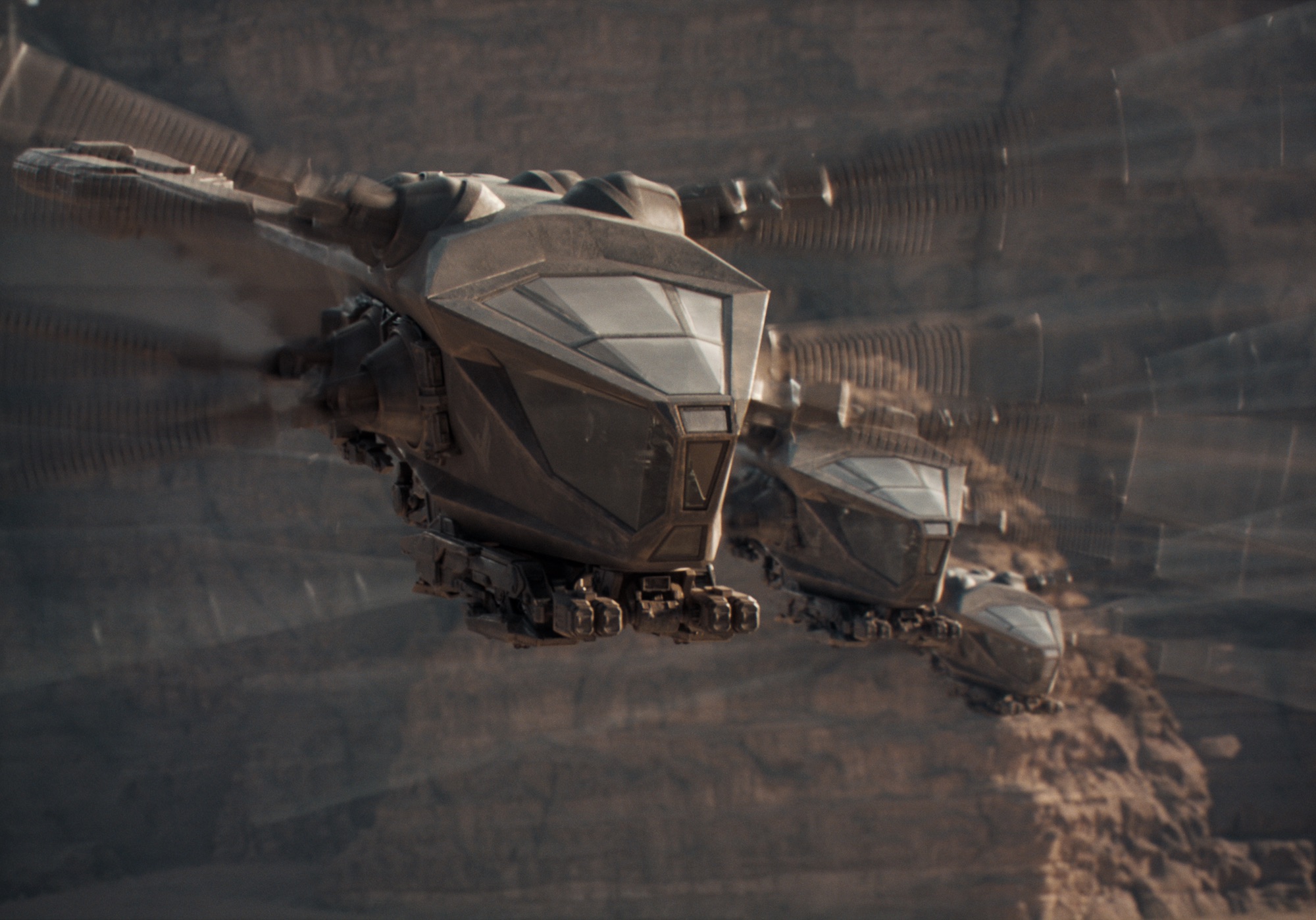Image Courtesy of DNEG © 2021 Legendary and Warner Bros. Entertainment Inc. All Rights Reserved.
“Dune: Part One” is the remarkable science-fiction epic and viewers’ introduction to Denis Villeneuve’s vision of Frank Herbert’s “Dune” universe. Join DFX Supervisor Stephen James and Animation Director Robyn Luckham for an eye-opening discussion of the pivotal role that DNEG played in bringing Villeneuve’s immersive vision to life. Sharing enthralling behind-the-scenes details of the project, SIGGRAPH dives into the meticulously detailed VFX work and impressive creatures that played a climactic role in the creation of an iconic film.
SIGGRAPH: What is the most important element of VFX when bringing a story to life?
Robyn Luckham (RL): For “Dune,” from my point of view in performance, the most important element of VFX was always coming from a place where reality and reference is king. We needed to respect that everything visible had to be as real as possible and developed with a logic as if it was built or biological born for real. As it was not fantasy, I would call it science fiction “reality.” This was the most overriding element for the performance team — to respect the real laws of the animated elements.
Stephen James (SJ): There is often a desire to add more and more into an image, but this can lead to being distracted from what really matters to the story. You can have a much greater impact on the audience if you are able to take a backseat to other elements of the story until those larger-than-life moments arrive. If you can find that right balance, you’ll have the audience totally believing in them.
SIGGRAPH: What scene from “Dune” are you most proud of? Why?
RL: There is so much I am proud of from “Dune.” The sandworm alone was a phenomenal achievement for such an iconic creature. The ornithopters also could have easily failed but were perfect, in my opinion, and were almost taken for granted. However, for me, I’m most proud of the dream shot of Paul fighting through an army of Sardaukar. This was an incredibly complex “Oner” shot to orchestrate with motion capture remotely due to COVID-19. There was a very high amount of performance data with no procedural assistance and that involved grafting 60-70 adjusted and timed animations to create this battle feeling.
SJ: From my point of view, the spice mining rescue scene comes to mind. It combined a lot of elements unique to “Dune,” such as extensive use of the sandscreen within the ornithopters and desert environments, ornithopter flight, and, of course, the sandworm and all of the sand FX that go with it. The way the visual effects came together with all other elements gave this scene such a massive impact. The scene constantly builds tension with the visuals, and a lot of restraint was necessary leading up to the final moments of the worm breaching to reveal its massive scale. The audience is right there with the character Paul in total disbelief of this creature’s power and scale.
SIGGRAPH: How does the process of creating VFX for science fiction (or “Dune” specifically) vary from other genres?
RL: For “Dune” specifically, the director Denis Villeneuve, the source material, and the client-side VFX Supervisor Paul Lambert were critical in enabling what we could achieve. For a project so vast and so big in status, it can be rare to get everyone pulling in the same direction to achieve great results. This is what happened on “Dune,” and the relationship between DNEG and Paul and between Paul and Denis enabled us to build a level of trust that is unique in big picture filmmaking.
SJ: With “soft” sci-fi like “Dune,” you can prioritize design and leave how it works to the audience’s imagination. Denis wanted to ensure all designs felt believable, but it was also important that they evoked a certain feeling. For example: Arrakeen city needed to always feel isolating for Paul, so a minimalist, brutalist design was developed to evoke this feeling.
SIGGRAPH: What element of VFX was most difficult to create for “Dune”?
RL: From the performance side of things, it was probably the ornithopters. There wasn’t any room to get this wrong, as these aircrafts could easily look a little silly. We focused on getting the right balance of blade work and attitude to find that sweet spot. It was a really delicate and technical balance to get there.
SJ: On a technical level, the Harkonnen attack on Arrakeen was the most difficult as it required a lot of coordination between environments, animation, crowds, FX, lighting, and compositing in what was often a full CG battle sequence.
SIGGRAPH: “Dune” has inspired many major sci-fi movies, shows, games, etc. What did you use as inspiration when creating the visual effects for “Dune”?
RL: I have been lucky to be involved with some seminal VFX projects, and the same consciousness for them I brought here: utter respect for the source material and the realism of the world you create. It is easy to be inspired by other projects, but with “Dune” being “Dune,” you don’t have to look far outside of its realm to get inspiration.
SJ: I love the books and took inspiration from them, as well as the incredible concept work created by the production design team.
SIGGRAPH: What piece of advice have you received from a VFX professional that you use in your own career and would give to others in the industry?
RL: I think humility is one of the biggest traits that I advise artists to have. Be humble and incredibly open to learning. Realize and respect those who have experience around you. I have had amazing artists to work with and alongside over the course of my career, and this also applied to my time on “Dune.” Each one can always teach you something new. It’s a long and wonderful career — just try not to get ahead of yourself.
SIGGRAPH: You presented “The VFX of ‘Dune’” as a Production Session at SIGGRAPH 2022. Tell us about that experience. Did any session participants ask any particularly interesting questions? What advice would you give to other VFX leaders presenting at a future SIGGRAPH?
RL: Speak slowly and clearly! Also, don’t be afraid to love what you are talking about. I think I might have been a little dry with mine, but I know I always got a big buzz watching amazing artists share what they love about their work — that for me makes a great talk. We are all very lucky to do the jobs we do.
SJ: This was my first time speaking at SIGGRAPH. The team organizing the talk did an incredible job and made it really easy for us. I was told to expect a few hundred people but closer to a few thousand showed up! After the talk, one aerospace engineer came to speak with Robyn and let him know that they had run tests and that the ornithopter design wouldn’t actually maintain flight which gave us a good laugh. If I had to give some advice to the future presenters, it would be to speak to what interests you about the work. By the time I did my talk, there were many technical breakdowns available for “Dune.” I decided to focus more on the approach that was taken to the visuals instead, because I was inspired by Denis and Paul’s overall philosophy. They never took any effect for granted and it led to some unique approaches that makes “Dune” stand out amongst other films.
Interested in sharing your stories at SIGGRAPH 2023? Submissions are open across several programs. Learn more.

Robyn Luckham is an animation director and DNEG’s global head of animation. Robyn is based out of DNEG’s Vancouver studio, where he is currently working on two unannounced projects for Warner Bros. Prior to this, Robyn completed work on Denis Villeneuve’s critically acclaimed “Dune.“ The two-and-a-half-year project included a large number of creature animation challenges, on-set collaboration, and intricate motion capture co-direction with Denis to create huge cinematic, digital battles. Robyn’s previous supervision work includes Tim Burton’s adaptation of the fantastical world of “Miss Peregrine’s Home for Peculiar Children,“ the Academy Award-nominated “Snow White and the Huntsman,“ Ron Howard’s critically acclaimed Formula 1 biopic “Rush,” and Howard’s “In the Heart of the Sea.” For that film, Robyn supervised DNEG’s animation and collaborated with a team of scientific advisors to portray accurate whale characteristics for the underwater creatures, including the movie’s iconic protagonist. As global head of animation, Robyn oversees all global technology and workflow operations for animation at DNEG, across film and episodic projects. He also leads DNEG’s talented global team of animators, delivering animated sequences on shows such as “Blade Runner 2049,” “Pacific Rim: Uprising,” “Avengers: Infinity War,” “Deadpool 2,” “Ant-Man and the Wasp,” and “Togo.” Robyn is heavily involved in creative client pitches; liaising with studio clients, designing the work coming into DNEG for animation, and projecting with the executive management team the future pipeline of animation work at the studio. Robyn has been at DNEG since 2011. He joined as animation lead on “John Carter” following a 10-year career in animation working for ILM, Weta Digital, and Framestore, on the likes of “Lord of the Rings: The Return of the King,“ “King Kong,” “Avatar,” and “Star Wars III: Revenge of the Sith.” He worked on “Avatar” for over two-and-a-half years and was heavily involved with Animation Director Andy Jones in creating the world as one of the lead animators.

Stephen James is a VFX supervisor at DNEG Vancouver. He is currently working as a VFX supervisor on an unannounced film for Warner Bros. and on the anticipated HBO series “The Last of Us.“ Most recently, Stephen supervised VFX work on director David Leitch’s action film “Bullet Train.” Prior to this, he worked as a DFX supervisor on Denis Villeneuve’s award-winning “Dune.” Before “Dune,“ Stephen served as a DFX supervisor on “Fast & Furious Presents: Hobbs & Shaw,“ a spin-off of the successful Hollywood franchise — for which he also helped deliver “The Fate of the Furious” and “Furious 7.“ His other recent work includes serving as compositing supervisor on “Deadpool 2” and as compositing sequence supervisor on the Academy Award-winning “Blade Runner 2049.“ Stephen also has experience on set, having served as on-set supervisor while covering reshoots for “Deadpool 2,” and then later reprising these responsibilities on “Hobbs & Shaw.“ Stephen’s visual effects career began with DNEG in 2005, when he worked as a digital paint artist on films such as “United 93,” “Children of Men,” and “Stranger Than Fiction.“ After debuting as a compositor on “Harry Potter and the Order of the Phoenix,” Stephen continued to work in this capacity on several large films across a variety of VFX studios. Some of his titles include “Thor,” “Iron Man 3,” “Elysium,” “Tropic Thunder,” “Zombieland,” “The Last Airbender,” and “Salt” to name just a few. After returning to DNEG in 2015, Stephen worked on “In the Heart of the Sea,“ “Alice Through the Looking Glass,” and “Star Trek Beyond.” Lately, he has focused on developing his skills in Unreal and creating more accessible solutions for real-time workflows on set.



